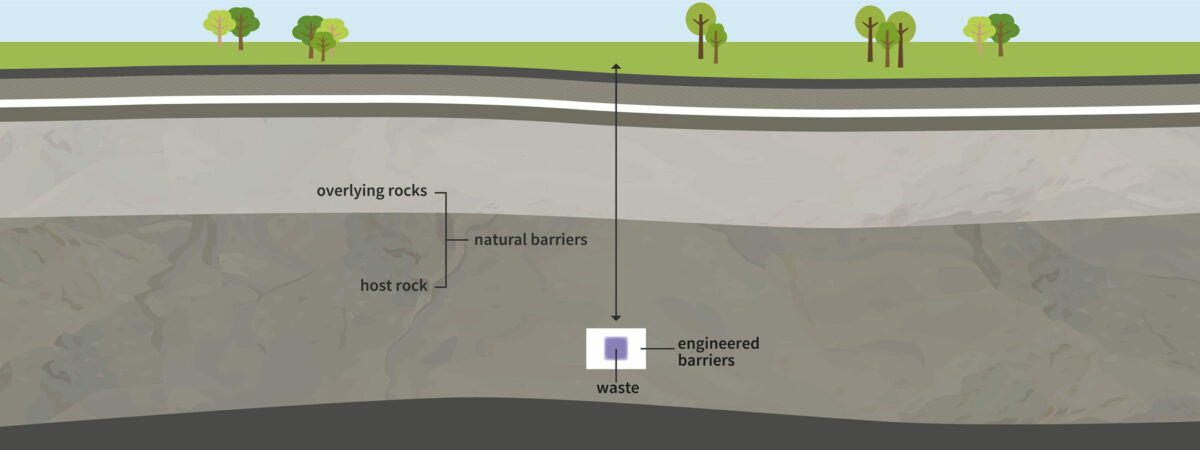Copeland GDF Working Group Newsletter
Welcome to our latest newsletter from the Copeland GDF Working Group, I hope everyone is keeping safe and well.
This fourth edition includes a Q&A on Geology in West Cumbria with Radioactive Waste Management’s Chief Geologist Jonathan Turner; our ‘Meet the Team’ latest which is an interview with David Moore, Copeland Borough Council’s Portfolio Holder for Nuclear Services; our regular Open to Question section and a reminder about our Virtual Exhibition.
We’ve been having some good conversations with people in the community about what the Working Group is, what we’re here for, what a Geological Disposal Facility is and why it’s needed somewhere in England or Wales.
With plenty of channels of communication open to us now to talk to people in our current virtual world, please do get in touch to discuss any areas of geological disposal – whether that’s to improve your understanding, raise any issues, talk about an opportunity or to let us help answer your questions.
It’s great that people are clicking on our website to access the recently-launched Virtual Exhibition and the feedback has been really good. As well as information there’s videos and graphics to provide you with as much detail as you need and it’s designed so you can take a look around in bitesize chunks, as your time allows.
We’ve got three social media channels – Twitter, Linkedin and, more recently Facebook, where we post our information and links for people to access. We’ve also recently started a digital advertising campaign and will be following that up with some local newspaper adverts as we’re aware that not everyone communicates digitally.
Please do remember you can contact us by telephone and access information that way on 0300 0660 100.
Our Working Group has three main tasks – beginning to understand community issues, concerns and questions about GDF; identifying a search area or areas within Copeland which could then be further investigated for potential locations for a GDF, and identifying initial members for a Community Partnership that could take that work forward.
As a reminder, the Working Group will not identify specific sites or decide on locations, it will merely suggest areas for further consideration potentially by a Community Partnership.
We’re in the very early stages of our conversations in Copeland and understanding people’s views now, as well as enabling people to access information, is very important to us. If we get a potential host community coming forward, they need to be able to make an informed decision further down the line on whether they want to host a GDF.
Community consent is at the heart of the process and a GDF cannot be built unless there’s a suitable site and a willing community.
We’re hoping to do a Copeland-wide survey as part of our work, asking a variety of questions relating to geological disposal, including what people know about it, what they know about radioactive nuclear waste and asking for views on a range of questions.
Copeland is an informed population as many people work in the nuclear industry but this will help to give us a good insight into what people currently know, what they would like to know and how we can help with that.
We can help get you some expert advice on any issues you may want to raise.
Please do share the newsletter sign-up link with anyone you feel would like information and thanks to everyone who’s been sharing our content, newsletter and virtual exhibition information so far – including Copeland Borough Council and the Cumbria Association of Local Councils (CALC).

Mark Cullinan
Independent Chair
Copeland GDF Working Group
Don’t forget to take a 360-degree virtual tour of a GDF
Our virtual exhibition offers an interactive experience to help people understand geological disposal and bring it to life.
It’s designed to give people a better understanding of what it’s all about with graphics, videos and information – replicating digitally a more conventional exhibition.
It offers an alternative way to access information about what a GDF is, get involved, ask questions and give your views during these current times.
Please come back to us with your views, comments and questions and feel free to share the virtual exhibition link with anyone who may be interested. To access the exhibition click here and let us know what you think.
Meet the Team
Councillor David Moore, Copeland Borough Council
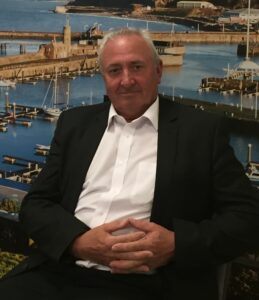
David Moore, Copeland Borough Council
Councillor David Moore, Copeland Borough Council’s Portfolio Holder for Nuclear Services, is a member of the Copeland GDF Working Group. He represents Copeland Borough Council, which is one of the four interested parties, and is supported by Rob Ward, the council’s Nuclear Lead Officer and also Steve Smith, Nuclear Projects and Programmes Manager.
David said: “Copeland Council’s participation in the Working Group means that the council, on behalf of our community, plays a key role in the process to establish whether there is a suitable location and willing host community for a Geological Disposal Facility (GDF) in Copeland.
“Regardless of a final location for a GDF, the Copeland community is affected fundamentally as the vast majority of materials that would go for disposal are located here, and the Sellafield site will be at the front end of the operational phase for decades to come.
“The Council’s engagement at the Working Group stage does not presuppose support for a GDF in Copeland or West Cumbria. If there’s a potentially suitable location and the process is taken forward, it would absolutely require the community’s support before any decisions are made.”
David, of Seascale, said the feedback he’s received so far has been positive.

“The inshore area being brought into play includes up to 20km out to sea which could potentially be looked at.” Councillor David Moore
“There are changes in the process this time – ultimately it will be a community-led decision which is made. Also, the potential for underground facilities off the coast, accessed from land, is being considered in the search this time. This inshore area being brought into play includes up to 20km out to sea which could potentially be looked at. This means there’s an extended area of around 60% to consider which wasn’t in play last time.”
David added: “The Working Group has currently got three workstreams we’re looking at – community engagement, search area and community partnership. As we work through these, and bring them together, we’ll hopefully identify possible search areas and potentially then take them through to forming a community partnership or partnerships, which is when we start to trigger the community benefits. The Lake District National Park has been excluded from consideration.”
Geology in West Cumbria
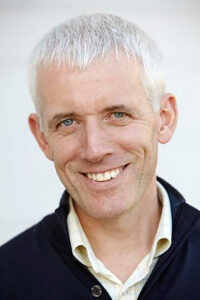
Jonathan Turner
Jonathan Turner is Radioactive Waste Management’s Chief Geologist. Here he answers your questions about the geology of West Cumbria in relation to potential geological disposal of higher activity radioactive waste. A GDF will only be considered where the geology is suitable, and there is a willing host community.
Didn’t NIREX (RWM’s predecessor) or RWM (during the Managing Radioactive Waste Safely process) rule out some/all of Cumbria because of unsuitable geology, so why are you looking here again?
NIREX did not rule out anywhere in West Cumbria. In the 1990s they did use deep borehole drilling and geophysics to investigate the subsurface geology in an area around Longlands Farm, a few kilometres south of Sellafield. These investigations aimed to understand whether the area was potentially suitable to construct an underground rock laboratory that was going to be used to explore the feasibility for the deep geological disposal of radioactive waste. However, before those investigations reached their conclusion, the project was discontinued following refusal of a planning application to construct the underground rock laboratory. The MRWS process between 2008-2013 also considered the potential of West Cumbria for a geological disposal facility. The British Geological Survey undertook a desk-based study which identified parts of the coastal plain as unsuitable for a GDF based upon criteria developed specifically for the MRWS process. That process ended in January 2013 when one of the three local authorities leading the discussions decided not to proceed further.
What do you know about the geology of West Cumbria?
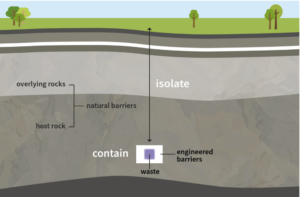
Diagram of a Multi-barrier GDF
The surface geology of West Cumbria was mapped by the British Geological Survey’s predecessor more than 100 years ago and lots is known about the rocks exposed in hillsides, river cuttings, cliffs and quarries. However relatively little is known about its deep subsurface geology because, unlike other parts of the UK, West Cumbria has not been intensively explored for geological resources. The sorts of things that are not well understood include how the rocks at the surface connect up with those at depth, and the nature of faults and fracture zones.
Will earthquakes cause a problem?
There are no known active fault lines in West Cumbria or indeed anywhere in the UK. Earthquakes are therefore no more likely to occur in West Cumbria than elsewhere. However, as part of any site investigations, the UK regulators will require RWM to gather information on rock properties and deep subsurface forces in order to understand whether drilling and construction activities could trigger earthquakes.
If you build a GDF in West Cumbria, won’t you disturb the water table and therefore contaminate our drinking water supplies?
No, a geological disposal facility would be constructed at depths of at least 200m so it will not disturb the
water table. Before recommending to Government that RWM can be granted a licence to undertake drilling and construction, the Environment Agency would require proof that these activities will not interfere with drinking water and natural aquifers.

RWM would need to carry out detailed site investigations to find out more about the deep subsurface geology beneath West Cumbria.
What types of rock exist deep underground/under the seabed in West Cumbria?
Quite a variety! West Cumbria and indeed most of the UK’s west coast forms the margin of an ancient rift valley. This means the rocks beneath the Irish Sea are very different to the older rocks exposed onshore. West Cumbria forms a large dome-shaped rock structure. The low-lying coastal fringe onshore in West Cumbria is made of much younger, reddish brown sedimentary rocks that extend beneath the Irish Sea. They comprise deeper layers of sandstone overlain by a mix of fine-grained clays and silts that also contain rock salt. Any RWM site investigations would include a detailed assessment of their potential as suitable host rocks in which to construct a geological disposal facility.
Are these rock types in West Cumbria suitable to build a GDF in?
Potentially yes, the deep subsurface geology beneath West Cumbria includes rock types with characteristics that could make good host rocks for a geological disposal facility, but there is not enough information to be sure at this stage. RWM would need to carry out detailed site investigations to find out more about them. The rocks deep beneath the seabed adjacent to the coast would be included in this, however the Lake District National Park area is already excluded from consideration.
Why can’t you use one of the many old mines in Cumbria instead of building a new expensive facility?
Disused mines are not good places in which to dispose of radioactive waste. This is because old mines comprise a network of often unsurveyed shafts and tunnels that could act as pathways for migration of harmful radioactive material to the surface.
For further information on geology please see the Virtual Exhibition on our website: Working Group Copeland (copeland.workinginpartnership.org.uk) as well as the Working Group Area: Working Group area – Working Group Copeland (workinginpartnership.org.uk)
If you would like to know anything else or would like a more detailed briefing please contact the Working Group at: gdfinfo-copeland@nda.gov.uk
Open to question
Since the Working Group was launched, we’ve had a range of questions from the public. Each issue we’ll aim to answer questions, and there are more on our website.
Where is the waste now?
Radioactive waste destined for disposal in a GDF is currently being stored safely and securely in surface
facility sites across the UK, with most of the waste stored at Sellafield.
These interim stores will need to be replaced every 50-100 years. Surface storage is not a permanent disposal solution as it requires constant monitoring, security, maintenance, and protection from natural processes, environmental changes and events, and malicious intervention.
Information about the UK’s radioactive waste inventory can be found here – 2019 Inventory reports | UK Radioactive Waste Inventory (UKRWI) (nda.gov.uk)
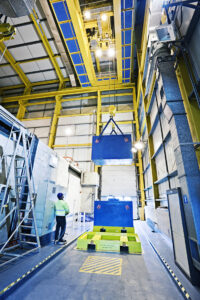
Radioactive waste destined for disposal in a GDF is currently being stored safely and securely in surface facility sites across the UK.
How much radioactive waste will go into a GDF?
Currently planning is on the basis that there could be around 750,000 cubic metres of packaged waste in total. This would be enough to fill around two thirds of Wembley Stadium.
How much of the radioactive waste is from old, existing, or new facilities?
About 90% of the volume of waste planned for disposal in a GDF is due to past or existing facilities. About 10% of the volume of waste destined for disposal in a GDF will come from currently planned new nuclear power stations. This figure is based on an anticipated 16GWe of new nuclear power station capacity.
How long will the waste be hazardous?
Whilst over 90% of the radioactivity will decay naturally in about 1000 years, some of the radioactive waste will remain hazardous for over 100,000 years.
Is all the waste destined for disposal in the GDF from the UK?
Yes, we do not import or export waste for disposal.


